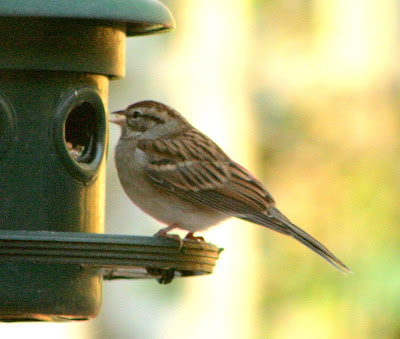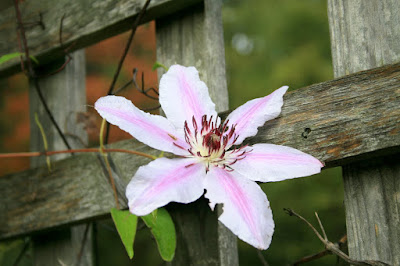So I cut some of the coneflower seedheads from the front garden and wove their stems into the latticework of our trellis to see if any goldfinches would go to that instead of the feeder. At least one goldie seems to approve.
Down below the thistle seed feeder, a mourning dove scavenges the spilled seed.
Meanwhile over at the mixed seed feeder, a chipping sparrow or 2 chow down on the millet seed.
And 3 purple finches (only the males have the reddish coloring) visit the mixed seed feeder and the thistle seed feeder.
And finally a comparison of the relative sizes of the hairy woodpecker (top) and the downy woodpecker (bottom). Notice the solid tail feathers of the hairy and the barred tail feathers of the downy.













 On a more recent rainy Sunday morning, I spotted the Huechera that I planted in August. I like how the raindrops have been caught in the leaves.
On a more recent rainy Sunday morning, I spotted the Huechera that I planted in August. I like how the raindrops have been caught in the leaves. Below is a photo showing the flaming colors of the maple tree in our back yard. This is always one of the first trees to change color.
Below is a photo showing the flaming colors of the maple tree in our back yard. This is always one of the first trees to change color. The clematis, which didn’t do very well this year, had one last blossom (below). You can see the color of the maple tree in background.
The clematis, which didn’t do very well this year, had one last blossom (below). You can see the color of the maple tree in background. Keith at Holdingmoments had a terrific post on English robins recently (http://holdingmoments.blogspot.com/2009/10/robin.html). American robins, which are much larger than the English robins, are thrushes and their red is only the breast. This robin youngster has lighter orange that hasn’t quite filled in all the way. In Georgia, where we lived before we moved here, robins were year-round residents. Here in Minnesota, the robins are seasonal and they have begun to migrate south. They will be a much welcomed herald for spring when they return.
Keith at Holdingmoments had a terrific post on English robins recently (http://holdingmoments.blogspot.com/2009/10/robin.html). American robins, which are much larger than the English robins, are thrushes and their red is only the breast. This robin youngster has lighter orange that hasn’t quite filled in all the way. In Georgia, where we lived before we moved here, robins were year-round residents. Here in Minnesota, the robins are seasonal and they have begun to migrate south. They will be a much welcomed herald for spring when they return.  Last weekend, we had a male Downy Woodpecker make repeated visits to our bird feeder. He would be at the feeder for 3-4 minutes to accumulate a supply of seeds and then fly to the nearby hickory tree to insert seeds into crevices in the bark. I tried to get photos, but couldn’t get outside without scaring him away. So I was inspired to take apart the window that looks out to the feeders. This is a double paned window that has mini-blinds between the panes of glass. So I undid the clips that hold the inside piece of glass in place, removed the glass, unhooked the bottom of the blinds from the bottom of the window, slid the top of the blinds out of their slot, and removed them entirely. Then, while the window was apart, I washed the inner side of the outside pane, both sides of the inside pane of glass, went outside and washed the outside of the outer pane, and then re-assembled the window. Voila! Now I can be a very lazy birder. I can sit in my favorite chair with my feet on the ottoman and take pictures using my zoom lens. How lazy is that? I moved the thistle (Nyger) feeder to a position I can also see from my chair. The cats also have window-side seats from which they can watch the birds to their hearts content, or perhaps discontent, since they can only watch, not pounce!
Last weekend, we had a male Downy Woodpecker make repeated visits to our bird feeder. He would be at the feeder for 3-4 minutes to accumulate a supply of seeds and then fly to the nearby hickory tree to insert seeds into crevices in the bark. I tried to get photos, but couldn’t get outside without scaring him away. So I was inspired to take apart the window that looks out to the feeders. This is a double paned window that has mini-blinds between the panes of glass. So I undid the clips that hold the inside piece of glass in place, removed the glass, unhooked the bottom of the blinds from the bottom of the window, slid the top of the blinds out of their slot, and removed them entirely. Then, while the window was apart, I washed the inner side of the outside pane, both sides of the inside pane of glass, went outside and washed the outside of the outer pane, and then re-assembled the window. Voila! Now I can be a very lazy birder. I can sit in my favorite chair with my feet on the ottoman and take pictures using my zoom lens. How lazy is that? I moved the thistle (Nyger) feeder to a position I can also see from my chair. The cats also have window-side seats from which they can watch the birds to their hearts content, or perhaps discontent, since they can only watch, not pounce! 
 Here are some of the pictures I took last weekend after I changed the window. This little chickadee is one of the most chipper and cheerful birds we see here. They stay around all winter and can brighten a very dull day.
Here are some of the pictures I took last weekend after I changed the window. This little chickadee is one of the most chipper and cheerful birds we see here. They stay around all winter and can brighten a very dull day.






